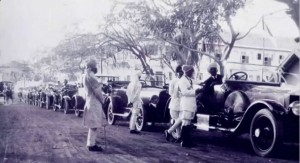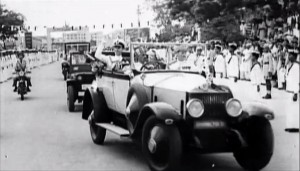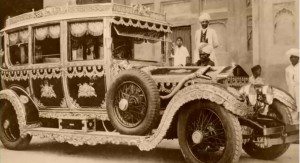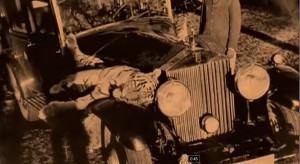There’s a fairytale about 2/3 of the way through Midnight’s Children that begins by recounting the good things possessed by a particular Pakistani prince:
Once upon a time, in the far northern princedom of Kif, there lived a prince who had two beautiful daughters, a son of equally remarkable good looks, a brand-new Rolls-Royce motor car, and excellent political contacts. This prince, or Nawab, believed passionately in progress, which was why he had arranged the engagement of his elder daughter to the son of the prosperous and well-known General Zulfikar; for his younger daughter he had high hopes of a match with the son of the President himself. As for his motor-car, the first ever seen in his mountain-ringed valley, he loved it almost as much as his children; it grieved him that his subjects, who had become used to using the roads of Kif for social intercourse, quarrels and games of hit-the-spittoon, refused to get out of its way. He issued a proclamation explaining that the car represented the future, and must be allowed to pass; the people ignored the notice, although it was pasted to shop-fronts and walls and even, it is said, to the sides of cows. The second notice was more peremptory, ordering the citizenry to clear the highways when they heard the horn of the car; the Kifis, however, continued to smoke and spit and argue in the streets. The third notice, which was adorned with a gory drawing, said that the car would henceforth run down anybody who failed to obey its horn. The Kifis added new, more scandalous to the poster; and then the Nawab, who was a good man but not one of infinite patience, actually did as he threatened. When the famous singer Jamila arrived with her family and impresario to sing at her cousin’s engagement ceremony, the car drove her without trouble from border to palace; and the Nawab said proudly, ‘no trouble; the car is respected now. Progress has occurred.”
At the time of first reading this, I took the Rolls in its everyday Western sense as a simple symbol of wealth and luxury, and the idea of a car as “progress” to symbolize, in typical fairytale muddling of historical temporality (the episode is set in Pakistan after independence), the role of Britain and of elites more generally in the political history of the subcontinent – even the suggestion that the power once held by Britain is now held by this local prince. But it turns out the Rolls-Royce as a symbol is more specifically loaded in the subcontinental context. (Click on images to enlarge.)
Over 800 Rolls Royce motor cars were imported into India from the UK between the early nineteen-teens and the Second World War. They were not, contrary to what pictures like the below suggest, owned by the British government or colonial officials who drove them around as a display of Britain’s wealth and power – they were rather owned by the Maharajas themselves, the princes who ruled those portions of India not directly under British control, and loaned to the British as a display of India’s wealth and power, thus serving as a poetically convoluted symbol of the cooperation between the Raj’s elites, regardless of nationality.
Purchased in quantity – sometimes as many as 12 at a time – the cars were an explicit measure of the Maharajahs’ wealth. In the nineteen-teens, some of the custom-designed cars cost as much as a townhouse in the city of London.
Apparently a Rolls-Royce from the 1920s could go for over 600 miles across ridiculously rocky terrain without breaking down. This was pretty unusual for cars at the time. So the Maharajas bought them and used them not only for lavish transportation and ceremonial events, but also for hunting…
…for transporting cricket teams, and for carrying garbage away from their lavish palaces. (Ok, that last was intended as an insult to Rolls-Royce, when a Hyderabadi prince was unhappy with the customer service at the local dealership.)
So when Rushdie’s Pakastani Nawab purchases the first Rolls-Royce anybody in his northern state has ever seen, it not only establishes him as a wealthy consumer of Western luxuries, appropriate for a prince of any place or era — but casts him as an imitation of Indian princes during the Raj. Throughout Midnight’s Children, Rushdie explores the permeability of the boundaries between India and Pakistan, socially, familially, culturally, politically. Turns out even this little detail works in the service of that conceit as well. Neat.
(Images and factoids about the Rolls-Royce in India are from the BBC Four documentary “The Maharajas’ Motor-Car: The Story of Rolls-Royce in India”.)





Pingback: Wednesday Geek Notes: Rushdie's Rolls-Royce « The Hooded Utilitarian | Weird Cars!
We tend to focus on the luxury aspect of the Rolls and forget how damn rugged they were. Lawrence of Arabia drove a Rolls during the 1st World War. The first tanks had Rolls-Royce motors.
Forget — or just be plain ignorant of. I was pretty amazed to learn how rugged they were. A 1920s car going 600 miles without breaking down on what was essentially an elephant path — that’s impressive.
The documentary that inspired this is worth watching if you can get your hands on it — short but really interesting.
Apparently Rolls-Royce spends thousands every year to protect its name against dilution by ads like ‘Acme, the Rolls-Royce of lawn mowers’.
Same goes for champagne. The champagne producers of France sued Yves Saint Laurent for naming a perfume “champagne”.
They won in Europe and lost in the USA. So the perfume known as ‘Champagne’ in America is called ‘Rive Gauche’ in Europe!
I remember a slogan from the ’60s, complete with catchy jingle: “Miller’s High Life, the Champagne of Bottled Beers.” That probably caused a few arterial strokes over at Moet Hennessy…
Grant Morrison’s run on X-Men had a throwaway line about how the Sentinel robots run on Rolls-Royce engines. If the RR people paid attention to comics, I’m sure they’d be thrilled to be associated with fictional tools of mutant genocide…